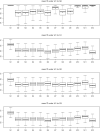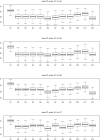Utility based approach in individualized optimal dose selection using machine learning methods
- PMID: 35343595
- PMCID: PMC9233043
- DOI: 10.1002/sim.9396
Utility based approach in individualized optimal dose selection using machine learning methods
Abstract
The goal in personalized medicine is to individualize treatment using patient characteristics and improve health outcomes. Selection of optimal dose must balance the effect of dose on both treatment efficacy and toxicity outcomes. We consider a setting with one binary efficacy and one binary toxicity outcome. The goal is to find the optimal dose for each patient using clinical features and biomarkers from available dataset. We propose to use flexible machine learning methods such as random forest and Gaussian process models to build models for efficacy and toxicity depending on dose and biomarkers. A copula is used to model the joint distribution of the two outcomes and the estimates are constrained to have non-decreasing dose-efficacy and dose-toxicity relationships. Numerical utilities are elicited from clinicians for each potential bivariate outcome. For each patient, the optimal dose is chosen to maximize the posterior mean of the utility function. We also propose alternative approaches to optimal dose selection by adding additional toxicity based constraints and an approach taking into account the uncertainty in the estimation of the utility function. The proposed methods are evaluated in a simulation study to compare expected utility outcomes under various estimated optimal dose rules. Gaussian process models tended to have better performance than random forest. Enforcing monotonicity during modeling provided small benefits. Whether and how, correlation between efficacy and toxicity, was modeled, had little effect on performance. The proposed methods are illustrated with a study of patients with liver cancer treated with stereotactic body radiation therapy.
Keywords: Gaussian process; random forest; utility matrix.
© 2022 The Authors. Statistics in Medicine published by John Wiley & Sons Ltd.
Conflict of interest statement
The authors declare no potential conflict of interests.
Figures








References
-
- Williams CKI, Rasmussen CE. Gaussian Processes for Machine Learning. Vol 2. Cambridge, MA: MIT Press; 2006.
Publication types
MeSH terms
Substances
Grants and funding
LinkOut - more resources
Full Text Sources
